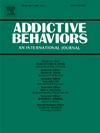Momentary predictors of tobacco lapse among African Americans during a quit attempt
IF 3.7
2区 医学
Q1 PSYCHOLOGY, CLINICAL
引用次数: 0
Abstract
Background and Aims
African American smokers are less likely to successfully quit and experience a greater burden of tobacco-related health outcomes than White individuals. There is a profound need to understand factors that impact tobacco cessation among African Americans who are undergoing a quit attempt. This study aimed to examine the within- and between-person associations of risk factors (motivation, self-efficacy, urge, positive affect, negative affect, smoking expectancies, and cigarette availability) with lapse.
Design and Setting
Observational study in the Houston, TX area that used ecological momentary assessment (EMA) to collect data for 10 days following a smoking quit attempt. Multilevel modeling was used to test associations between risk factors and lapse.
Participants
N = 211 African American adults, 51 % female, and ages 18–74.
Measurements
EMA was used to assess risk factors (motivation, self-efficacy, urge, positive affect, negative affect, smoking expectancies, and cigarette availability) and lapse.
Findings
At the within-person level, moments characterized by greater urge, smoking expectancies, and cigarette availability were associated with greater risk of lapse in daily life. At the between-person level, those who had lower motivation and self-efficacy and greater urge, smoking expectancies, and cigarette availability were more likely to lapse in daily life.
Conclusions
The current study addresses important theoretical underpinnings regarding the dynamic nature of predictors of lapse. Although some predictors (urge, smoking expectancies, cigarette availability) did have a significant effect with lapse in expected directions, between person effects may be increasingly important in this population, and additional momentary predictors should be explored in future research.
非裔美国人在戒烟过程中烟草失效的瞬间预测因子。
背景和目的:与白人相比,非裔美国人吸烟者成功戒烟的可能性较小,并且承受着更大的烟草相关健康后果负担。我们迫切需要了解影响正在尝试戒烟的非裔美国人戒烟的因素。本研究旨在探讨个人内部和个人之间的风险因素(动机、自我效能、冲动、积极影响、消极影响、吸烟预期和香烟可得性)与过失的关系。设计和设置:在德克萨斯州休斯顿地区的观察性研究,使用生态瞬时评估(EMA)收集戒烟尝试后10天的数据。采用多水平模型来检验危险因素与失误之间的关系。参与者:211名非裔美国成年人,51%为女性,年龄在18-74岁。测量方法:EMA用于评估风险因素(动机、自我效能、冲动、积极影响、消极影响、吸烟预期和香烟可得性)和失效。研究发现:在个人层面上,以更大的冲动、吸烟预期和香烟可得性为特征的时刻与日常生活中更大的失效风险相关。在人与人之间的层面上,那些动机和自我效能较低、冲动、吸烟期望和香烟可得性较高的人更有可能在日常生活中失败。结论:目前的研究解决了重要的理论基础,关于动态性质的预测失效。虽然一些预测因素(冲动、吸烟预期、香烟可得性)确实对预期方向的偏离有显著影响,但在这一人群中,人与人之间的影响可能越来越重要,在未来的研究中应该探索更多的瞬时预测因素。
本文章由计算机程序翻译,如有差异,请以英文原文为准。
求助全文
约1分钟内获得全文
求助全文
来源期刊

Addictive behaviors
医学-药物滥用
CiteScore
8.40
自引率
4.50%
发文量
283
审稿时长
46 days
期刊介绍:
Addictive Behaviors is an international peer-reviewed journal publishing high quality human research on addictive behaviors and disorders since 1975. The journal accepts submissions of full-length papers and short communications on substance-related addictions such as the abuse of alcohol, drugs and nicotine, and behavioral addictions involving gambling and technology. We primarily publish behavioral and psychosocial research but our articles span the fields of psychology, sociology, psychiatry, epidemiology, social policy, medicine, pharmacology and neuroscience. While theoretical orientations are diverse, the emphasis of the journal is primarily empirical. That is, sound experimental design combined with valid, reliable assessment and evaluation procedures are a requisite for acceptance. However, innovative and empirically oriented case studies that might encourage new lines of inquiry are accepted as well. Studies that clearly contribute to current knowledge of etiology, prevention, social policy or treatment are given priority. Scholarly commentaries on topical issues, systematic reviews, and mini reviews are encouraged. We especially welcome multimedia papers that incorporate video or audio components to better display methodology or findings.
Studies can also be submitted to Addictive Behaviors? companion title, the open access journal Addictive Behaviors Reports, which has a particular interest in ''non-traditional'', innovative and empirically-oriented research such as negative/null data papers, replication studies, case reports on novel treatments, and cross-cultural research.
 求助内容:
求助内容: 应助结果提醒方式:
应助结果提醒方式:


